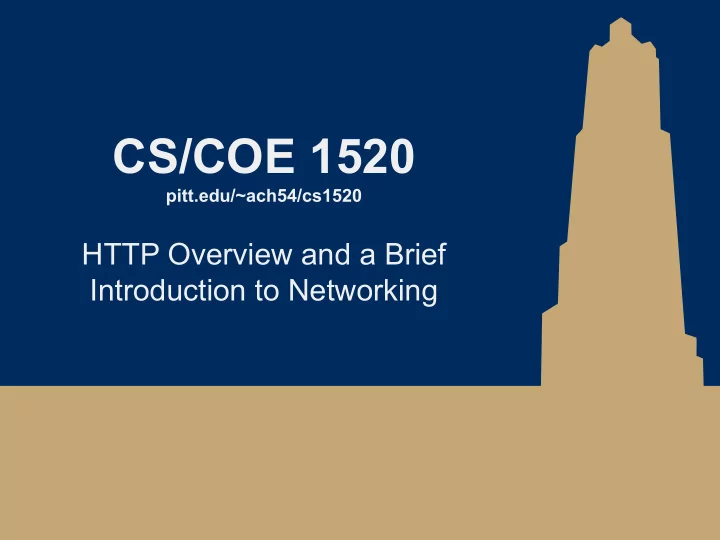

CS/COE 1520 pitt.edu/~ach54/cs1520 HTTP Overview and a Brief Introduction to Networking
Render! 2
X I'd like to see X Gimme X 3
HTTP: the HyperText Transfer Protocol ● Originally developed by Sir Tim ● HTTP v1.0 standard presented 1996 ● HTTP/1.1 standard finalized in 1997 ○ Via RFC 2068 ■ Though improvements and updates in RFC 2616 (1999) essentially replace RFC 2068 as the definition of HTTP/1.1 ● In 2009, Google produced SPDY, another protocol for the transfer of web traffic ○ Doesn't replace HTTP, provides a tunnel for HTTP traffic ● In 2015, HTTP/2.0 standard was finalized ○ Based around SPDY ○ Google has since deprecated SPDY 4
HTTP basics: GET ● First method implemented ○ HTTP now has several methods defined that specify the action that is requested to be performed on given resource ● Simply fetch the resource at some URL 5
GET / HTTP/1.1 Host: cs.pitt.edu ... HTTP/1.1 200 OK Content-Type: text/html; charset = UTF-8 … Header <!DOCTYPE html> <html> Body ... 6
So the Host attribute of the request says where to go ● Well… no, not really… 7
10.0.0.2 10.0.0.1 25 23 143 80 10.0.0.4 10.0.0.3 22 22 443 443 8
So how do we get HTTP requests to the webserver? TCP/IP Model Application Layer Transport Internet Link Layer 9
To send an HTTP request MAC address of Link layer... next hop, etc. IP Destination IP TCP HTTP/2 Destination port HTTP HTTP 10
How do we get information to the server? ● POST ○ Attaches data with the request that should be handled by the specified resource ■ E.g., ● The result of a web form ● A new entry to add to a database ● PUT ○ Attaches data that should be placed at the specified resource ■ If the resource does not currently exist, specified data should now be that resource identified by the given URL 11
PUT sounds dangerous... ● Safe HTTP methods ○ Should only request a resource, should not change the state of the server ○ GET is (by convention) a safe method ● POST and PUT are intended to cause side-effects (i.e., change the state of the server) 12
In theory, there is no difference between theory and practice ... ● In practice there is ● URL format: scheme:[//[user:password@]host[:port]][/]path[?query][#fragment] ● The URL query string can be used to affect server state ● E.g.: ○ http://example.com/storefront?user=adam&newitem=laptop ■ Could be used by the example.com webstore app to have me request to buy a laptop ● This is BAD 13
HTTP Methods ● GET ● HEAD ○ Like GET, but returns headers only, no body ● POST ● PUT ● DELETE ○ Delete listed resource 14
Comparisons of HTTP Methods 15
HTTP Status Codes ● 200 ○ OK ● 301 ○ Moved Permanently ● 400 ○ Bad Request ● 403 ○ Forbidden ● 404 ○ Not Found ● 500 ○ Internal Server Error ● … 16
Linux Apache MySQL PHP GET start.php HTTP/1.1 17
18
19
20
Recommend
More recommend